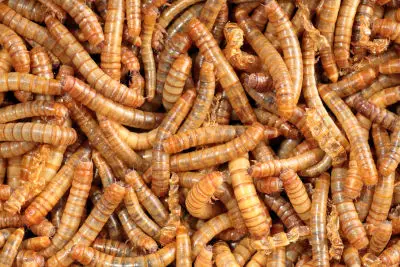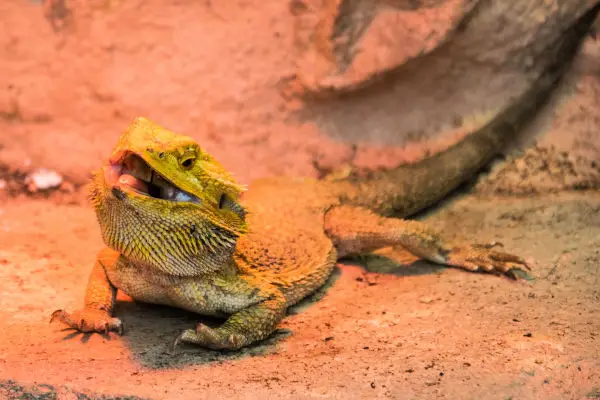Where Do Bearded Dragons Live? (Habitat, predators & more)
While you research Bearded Dragons (Click here to learn from this guide, why 1 in 3 Bearded Dragon owners miss this when they are researching them), you may be wondering where they came from originally. Let me explain…
Where do bearded dragons live? Bearded Dragons originate from Australia and mainly located in desert areas. However, they can be found in the United States and Europe, but mainly bred in captivity due to Australias strict animal exportation rules.
| Are these foods dangerous for your Beardie? | |
| Avacado? Click here to learn, from this guide, if this food is dangerous |  |
| Superworms? Click here to learn, from this guide, if this food is dangerous |  |
Now that you know where they are from keep reading to learn when they turned up in the United States, where their name comes from (and how obvious this is), how they use speed to avoid predators in the wild, and so much more.
When did Bearded Dragons appear in the United States?
Now that you understand Bearded Dragons come from Australia, you may be wondering when they made their way to the United States. Therefore, in this section, I will explain when this happened and how they have expanded in population since then.
They were originally introduced to the United States back in the 1990s. Since then they have rapidly expanded, mainly by being bred domestically (more on this later). They have now become one of the most, if not, the most popular lizard pet in the united states.
Can the size of a Bearded Dragon determine his age?

Measuring your Beardie
If you have ever wondered how you can get an idea of a Bearded Dragons age, without knowing his history, you are in luck. In luck. I will explain how this is possible by using their size. As well as presenting you with a useful chart that can help to guide you.
| Size (Inches) | Age (Months) |
| 3-4 | 0-1 |
| 5-9 | 2 |
| 8-11 | 3 |
| 9-12 | 4 |
| 11-16 | 5 |
| 11-18 | 6 |
| 13-20 | 8 |
| 16-22 | 12 |
Why are they called Bearded Dragons?
The name Bearded Dragon sounds quite suggestive, right? But, they don’t have a beard, or do they? In this section, I will explain where their name came from, and how obvious it really is once you now.
Yes, looking at a Beardie, in ist normal profile, one could argue that it doesn’t have a beard, right? But when it is trying to attract a mate or intimidate any potential predators it will puff up its throat (Click here to understand what they use this throat pouch for).
When you look at this puffed-up throat it has an effect on the spines, it turns them black. This combination of the puffed-up throat and black spines makes it resemble a beard. Hence the reason it is called this, are you with me?
Do Bearded Dragons head bob in their natural habitat?
Bearded Dragons have an array of interesting behaviors. One of the more well-known ones is the head bob movement. But, do they do this naturally, in their original native environment? In this section, I will address this question and why the head bob is used.
This weird behavior is seen in many different contexts but is believed to be heavily linked to mating. The idea is it is used to show dominance amongst any other male competitor to win over the female.
This may explain why it sometimes is seen when you approach them, they may be using it to warn you off. Are you with me?
Are they able to get away from their predators fast?
When you look at a Bearded Dragon you may assume that it is a slow-moving, sluggish character, right? This is a reasonable assumption, based on its appearance, but in reality, you may be surprised. In this section, I will explain how fast they can move and how this helps them to survive in their native environment.
According to Healthy Pets, Bearded Dragons can reach speeds up to 9mph. Yes, that fast! I admit, this sounds like quite a speed fro such a small, sluggish looking reptile, right?
In their natural habitat, most of their day is spent basking in the sun. But, if they are attacked (more on this later), they can use their speed to getaway.
Do Bearded dragons swim in the wild?
By now you have learned that Bearded Dragons originate from deserts of Australia. So, it is easy to assume that they are not keen on swimming, or ever have a need to do so, right? Well, in this section I will explain if this assumption is true or not.
Yes, some Bearded dragons do swim in the wild. However, some just like to paddle in a shallow puddle of water. Others may actually like to swim. So it can vary based on the individual Bearded Dragon.
For those that attempt o swim, they use their beard to their advantage. This puffed-up beard can help to keep them buoyant while they are swimming because they still need to breathe above the water level (through their skin? click here).
Can Bearded dragons be imported from Australia?

Bearded Dragon in a rocky background
With Bearded Dragons originating from Australia it is a simple assumption that they have spread to other parts of the world from their natural habitat. But, in this section, I will explain why this is more complicated than you will assume.
Yes, Australia is their original habitat, but they have some strict animal export rules to protect them. So, many of the Bearded Dragons you see in other countries are bred in captivity.
This is one of the reasons why there are so many different morphs (Click here to see if there is green beardie morph, or not).
Can their sex be changed?
You may, or may not know, that Bearded Dragons lay eggs (Click here to see where they do this). Before they are hatched their embryo is developed and formed. But, is it possible for their sex to be changed during this time?
Yes, according to this site, their sex can be changed before the eggs are hatched. Apparently a study was done to prove this. And, allegedly, once the incubated eggs were taken above 90 degrees F, the male embryo was transformed into a female before it was hatched.
Do they have a mating season in the wild?
In this section, I will explain more about the Bearded Dragons’ behavior in the wild. In particular, he’s mating patterns. You will learn how different it is for them in the wild, compared to their life in captivity.
In the wild Bearded Dragons do have a mating season. This is typically dictated by the seasonal changes they encounter in their country. However, when they are in captivity this completely changes. They are known to mate throughout the year. Meaning their egg clutches can be hard to predict.
My thinking is, because of the regulated heating Beardie owners use, this heavily affects their mating habits in captivity.
Are bearded Dragons hunted in the wild?
Bearded Dragons are predators in the wild and in captivity. This is evident as you see them devour a live cricket when you put one in their enclosure, right? But, what about when they are in their natural habitat? Are they also hunted?
Yes, Bearded Dragons have predators. One of the indicators, believe it or not, is their eyes. As weird as this may sound at first, have a close look at their eyes. Do you see how wide apart they are?
This isn’t by luck, nature has designed them in this way to protect them. Think of a dear, it is always on the lookout for his predators, right? This is why he too has widespread eyes.
With this distinct advantage, he can monitor his attackers from a wider angle. Especially when compared to the eyes of us humans.
Their Predators
Their predators are typically birds of prey as well as dingos. What is a dingo? This animal is commonplace in Australia. According to Wikipedia, it is a medium-sized dog that is found in Australia.
Related Questions:
In this section, I will answer questions related to Bearded Dragons’ stress levels, if they are tame in the wild, and how sociable they are in the wild in comparison to captivity. If you have more questions feel free to contact me.
Q: Do Bearded Dragons get stressed in their natural habitat?
Yes, Bearded Dragons do get stressed in their natural habitat. However, beardies getting stress marks (Click here to see what they are and how to get rid of them), is more commonly know in captivity from mistakes made by their owners.
Q: Are Bearded Dragons tame in the wild?
No, Bearded Dragons are not naturally tame. In captivity, Beardies do appear to enjoy human contact (Click here to see why this is). But, this is something they have learned from regular human interaction. In the wild, they stay clear of humans and have no need for them to get food or entertain themselves.
Yes, you can see some Bearded Dragons being Social (Click here to see why) in the wild, but mainly for mating. They are also known to bundle on top of each other. But, in captivity, it is advised to keep them in their own enclosure (Click here to see if your Beardie can be kept in a wire cage) to stop the fighting, especially if they are males.